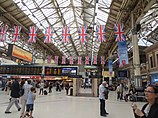City of Westminster
City of Westminster | |
|---|---|
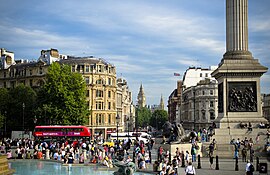 Trafalgar Square,an open plaza in the city | |
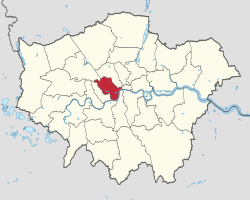 Westminster shown withinGreater London | |
| Coordinates:51°30′44″N00°09′48″W/ 51.51222°N 0.16333°W | |
| Sovereign state | United Kingdom |
| Country | England |
| Region | London |
| Ceremonial county | Greater London |
| Created | 1 April 1965 |
| Admin HQ | City Hall,Victoria Street |
| Government | |
| • Type | London borough council |
| • Body | Westminster City Council |
| • London Assembly | Tony Devenish(Conservative) |
| •MPs |
|
| Area | |
| • Total | 8.29 sq mi (21.48 km2) |
| • Rank | 288th(of 296) |
| Population (2022) | |
| • Total | 211,365 |
| • Rank | 92nd(of 296) |
| • Density | 25,000/sq mi (9,800/km2) |
| Time zone | UTC(GMT) |
| • Summer (DST) | UTC+1(BST) |
| Postcodes | |
| Area code | 020 |
| ISO 3166 code | GB-WSM |
| ONS code | 00BK |
| GSS code | E09000033 |
| Police | Metropolitan Police |
| Website | westminster.gov.uk |
TheCity of Westminsteris aLondon boroughwithcity statusinGreater London,England. It is the site of the United Kingdom'sHouses of Parliamentand much of theBritish government.It contains a large part ofcentral London,including most of theWest End,such as the major shopping areas aroundOxford Street,Regent Street,PiccadillyandBond Street,and the entertainment district ofSoho.ManyLondonlandmarks are within the borough, includingBuckingham Palace,Westminster Abbey,Whitehall,Westminster Cathedral,10 Downing Street,andTrafalgar Square.
The borough also has a number of majorparks and open spaces,includingHyde Park,Green Parkand most ofRegent's Park.Away from central London the borough also includes various inner suburbs, includingSt John's Wood,Maida Vale,Bayswater,BelgraviaandPimlico.The borough had a population of 204,300 at the 2021 census.
The original settlement ofWestminsterwas historically a separate urban area to the west of London, growing up around theminster churchof Westminster Abbey. Westminster was an important centre of royal authority from Saxon times, and was declared a city in 1540. It was gradually absorbed into the urban area of London, but London's official city boundaries remained unchanged, covering just the area called theCity of London,broadly corresponding to the medieval walled city. From the 19th century somemetropolis-wide administrative bodies were introduced. TheCounty of Londonwas created in 1889, replaced in 1965 by the larger administrative area ofGreater London,which since 2000 has been led by theMayor of London.The cities of London and Westminster retain their separate city statuses despite having long been part of the same urban area.
The modern borough was created in 1965 as part of the same reforms which created Greater London, covering the area of the three formermetropolitan boroughsofWestminster,PaddingtonandSt Marylebone.The local authority isWestminster City Council.To the east, Westminster borders theCity of London,with the boundary marked byTemple Bar.Other neighbouring boroughs (anti-clockwise from north-east) areCamden,Brent,Kensington and Chelsea,WandsworthandLambeth,the latter two being separated from Westminster by theRiver Thames.Charing Crossin Westminster is the notional centre of London, beingthe pointfrom which distances from London are measured.
History[edit]
After the depopulation ofRoman Londonin the 5th century, anAnglo Saxonagricultural and trade settlement likely developed to its west, associated with theMiddle Saxons,sometimes calledLundenwic('London village' or London port'). Over time,Lundenburh('London fort'), the former Roman city with its still-existing Roman walls, was repopulated and Lundenwic declined, becoming pastoral and partly known asAldwych(Aldwic—'old village'), the name of which lives on for a section of Westminster.[1]

The origins of the City of Westminster pre-date theNorman Conquestof England. In the mid-11th century, KingEdward the Confessorbegan the construction of an abbey at Westminster, only the foundations of which survive today. Between the abbey and the river he built a palace, thereby guaranteeing that the seat of Government would be fixed at Westminster, and inevitably drawing power and wealth west out of the old City of London.[2]
For centuries Westminster and the City of London were geographically quite distinct. It was not until the sixteenth century that houses began to be built over the adjoining fields, eventually absorbing nearby villages such asMaryleboneandKensington,and gradually creating the vastGreater Londonthat exists today.
Henry VIII'sdissolution of the monasteriesabolished the abbey at Westminster, although the formerabbey churchis still calledWestminster Abbey.The church was briefly thecathedralof theDiocese of Westminstercreated from part of theDiocese of Londonin 1540, byletters patentwhich also grantedcity statusto Westminster, a status retained after the diocese was abolished in 1550.[3]
Administrative history[edit]
The area was historically part of the county ofMiddlesex.Whilst an important centre of royal authority fromSaxontimes, Westminster was not formally incorporated as aboroughfor local government purposes until 1900. However, it was declared a city in 1540 on the elevation of Westminster Abbey to being acathedral.[4]From at least 1545 there was also aWestminster parliamentary borough(constituency).[5]TheAnglican Diocese of Westminsterwas short-lived, being absorbed back into theDiocese of Londonin 1550. Despite having no borough corporation and having ceased to be the seat of a diocese, Westminster continued to be described as a city. In 1585 theWestminster Court of Burgesseswas established to administer certain judicial powers in an area known as theCity and Liberty of Westminster.[6]

From 1856 the area was also governed by theMetropolitan Board of Works,which was established to provide services across themetropolisof London. In 1889 the Metropolitan Board of Works' area was made theCounty of London.From 1856 until 1900 the lower tier of local government within the metropolis comprised variousparish vestries and district boards.Within the City and Liberty of Westminster, the three parishes ofSt George Hanover Square,St James PiccadillyandSt Martin-in-the-Fieldswere governed by theirvestries,whilst the parishes covering the central part of Westminster formed theWestminster Districtand the parishes and territories adjoining the border with theCity of Londonformed theStrand District.Beyond the liberty to the north, the two parishes ofPaddingtonandSt Marylebonewere also governed by their vestries.[7]The Westminster District was renamed the St Margaret and St John Combined Vestry in 1887, and unsuccessfully petitioned to be incorporated as a borough in 1897.[8]
In 1900 the lower tier of local government within the County of London was reorganised intometropolitan boroughs.The parish of Paddington became theMetropolitan Borough of Paddington,and the parish of the St Marylebone became theMetropolitan Borough of St Marylebone.The various territories within the old City and Liberty of Westminster became theMetropolitan Borough of Westminster.[9]The new boroughs came into being on 1 November 1900; a few days ahead of that aroyal charterwas issued conferring city status on the new borough of Westminster from its creation.[10]The Court of Burgesses, which had ceded most practical powers to the newer authorities, was finally abolished in 1901.[11]
The modern borough was created in 1965 under theLondon Government Act 1963.It was a merger of the old Paddington, St Marylebone and Westminster metropolitan boroughs, and Westminster's city status was transferred to the enlarged borough.[12][13]In 1966 the city was granted the right to appoint alord mayor.[14]
Governance[edit]

The local authority is Westminster City Council, which meets at Westminster Council House (also known asMarylebone Town Hall) and has its main offices atWestminster City Hallon Victoria Street.
Greater London representation[edit]
Since 2000, for elections to theLondon Assembly,the borough forms part of theWest Centralconstituency.
UK Parliament[edit]
| 1918 | 1950 | 1974 | 1983 | 1997 | 2010 |
|---|---|---|---|---|---|
| St Marylebone | Westminster North | Regent's Park and Kensington North | Westminster North | ||
| Paddington North | Paddington | ||||
| Paddington South | Cities of London and Westminster | ||||
| Westminster St George's | Cities of London and Westminster | Cities of London and Westminster | |||
| Westminster Abbey | |||||
| City of London | |||||
Demographics[edit]

| Year | Pop. | ±% |
|---|---|---|
| 1801 | 220,188 | — |
| 1811 | 245,254 | +11.4% |
| 1821 | 288,851 | +17.8% |
| 1831 | 344,200 | +19.2% |
| 1841 | 368,910 | +7.2% |
| 1851 | 422,850 | +14.6% |
| 1861 | 446,263 | +5.5% |
| 1871 | 469,677 | +5.2% |
| 1881 | 493,090 | +5.0% |
| 1891 | 462,837 | −6.1% |
| 1901 | 441,857 | −4.5% |
| 1911 | 421,865 | −4.5% |
| 1921 | 396,406 | −6.0% |
| 1931 | 372,566 | −6.0% |
| 1941 | 334,448 | −10.2% |
| 1951 | 300,461 | −10.2% |
| 1961 | 267,126 | −11.1% |
| 1971 | 237,614 | −11.0% |
| 1981 | 163,893 | −31.0% |
| 1991 | 187,526 | +14.4% |
| 2001 | 181,279 | −3.3% |
| 2011 | 219,396 | +21.0% |
| Source: A Vision of Britain through time, citing Census population | ||
Ethnicity[edit]

The following table shows the ethnic group of respondents in the 1991 to 2021 censuses in Westminster.
| Ethnic group | Year | |||||||||||
|---|---|---|---|---|---|---|---|---|---|---|---|---|
| 1971 estimations[15] | 1981 estimations[16] | 1991 census[17] | 2001 census[18] | 2011 census[19] | 2021 census[20] | |||||||
| Number | % | Number | % | Number | % | Number | % | Number | % | Number | % | |
| White:Total | – | 93.1% | 163,612 | 85.6% | 148,461 | 79.1% | 132,715 | 73.12% | 135,330 | 61.68% | 112,732 | 55.1% |
| White:British | – | – | – | – | – | – | 87,938 | 48.51% | 77,334 | 35.25% | 57,162 | 28.0% |
| White:Irish | – | – | – | – | – | – | 6,574 | 3.63% | 4,960 | 2.26% | 3,742 | 1.8% |
| White:Gypsy or Irish Traveller | – | – | – | – | – | – | – | – | 76 | 0.03% | 49 | 0.0% |
| White: Roma | – | – | – | – | – | – | – | – | – | – | 1,503 | 0.7% |
| White:Other | – | – | – | – | – | – | 38,203 | 21.07% | 52,960 | 24.14% | 50,276 | 24.6% |
| Asian or Asian British:Total | – | – | 10,624 | 5.5% | 17,198 | 9.2% | 20,184 | 11.13% | 31,862 | 14.52% | 34,242 | 16.7% |
| Asian or Asian British:Indian | – | – | 2,604 | 3,710 | 5,665 | 3.12% | 7,213 | 3.29% | 7,965 | 3.9% | ||
| Asian or Asian British:Pakistani | – | – | 841 | 1,240 | 1,828 | 1.01% | 2,328 | 1.06% | 2,461 | 1.2% | ||
| Asian or Asian British:Bangladeshi | – | – | 1,768 | 3,991 | 5,000 | 2.76% | 6,299 | 2.87% | 7,533 | 3.7% | ||
| Asian or Asian British:Chinese | – | – | 2,270 | 2,910 | 4,077 | 2.25% | 5,917 | 2.70% | 6,625 | 3.2% | ||
| Asian or Asian British: Other Asian | – | – | 3,141 | 5,347 | 3,614 | 1.99% | 10,105 | 4.61% | 9,658 | 4.7% | ||
| Black or Black British:Total | – | – | 11,503 | 6% | 13,862 | 7.4% | 13,481 | 7.44% | 16,472 | 7.51% | 16,456 | 8% |
| Black or Black British:African | – | – | 3,295 | 4,535 | 5,613 | 3.10% | 9,141 | 4.17% | 10,451 | 5.1% | ||
| Black or Black British:Caribbean | – | – | 6,519 | 7,163 | 6,678 | 3.68% | 4,449 | 2.03% | 4,307 | 2.1% | ||
| Black or Black British:Other Black | – | – | 1,689 | 2,164 | 1,190 | 0.66% | 2,882 | 1.31% | 1,698 | 0.8% | ||
| Mixed or British Mixed:Total | – | – | – | – | – | – | 7,480 | 4.13% | 11,395 | 5.19% | 13,335 | 6.5% |
| Mixed: White and Black Caribbean | – | – | – | – | – | – | 1,382 | 0.76% | 1,869 | 0.85% | 2,061 | 1.0% |
| Mixed: White and Black African | – | – | – | – | – | – | 1,204 | 0.66% | 1,927 | 0.89% | 2,089 | 1.0% |
| Mixed: White and Asian | – | – | – | – | – | – | 2,436 | 1.34% | 3,584 | 1.63% | 3,718 | 1.8% |
| Mixed: Other Mixed | – | – | – | – | – | – | 2,458 | 1.36% | 4,015 | 1.83% | 5,467 | 2.7% |
| Other: Total | – | – | 5,284 | 8,239 | 7,426 | 4.10% | 24,337 | 11.09% | 27,471 | 13.5% | ||
| Other: Arab | – | – | – | – | – | – | – | – | 15,724 | 7.17% | 15439 | 7.6% |
| Other: Any other ethnic group | – | – | – | – | – | – | 7,426 | 4.1% | 8,613 | 3.93% | 12032 | 5.9% |
| Ethnic minority: Total | – | 6.9% | 27,411 | 14.4% | 39,299 | 20.9% | 48,571 | 26.79% | 84,066 | 38.32% | 91,504 | 44.9% |
| Total | – | 100% | 191,024 | 100% | 187,700 | 100% | 181,286 | 100.00% | 219,396 | 100.00% | 204,236 | 100% |
Religion[edit]
| Religion | 2001[21] | 2011[22] | 2021[23] | |||
|---|---|---|---|---|---|---|
| Number | Of total | Number | Of total | Number | Of total | |
| Christian | 99,797 | 55.05% | 97,877 | 44.61% | 76,245 | 37.3% |
| No religion | 29,300 | 16.16% | 44,542 | 20.30% | 52,936 | 25.9% |
| Muslim | 21,346 | 11.77% | 40,073 | 18.27% | 40,873 | 20.0% |
| Religion not stated | 15,877 | 8.76% | 20,519 | 9.35% | 19,179 | 9.4% |
| Jewish | 7,732 | 4.27% | 7,237 | 3.30% | 5,628 | 2.8% |
| Hindu | 3,497 | 1.93% | 4,178 | 1.90% | 4,457 | 2.2% |
| Buddhist | 2,392 | 1.32% | 3,194 | 1.46% | 2,603 | 1.3% |
| Other religion | 945 | 0.52% | 1,280 | 0.58% | 1,741 | 0.9% |
| Sikh | 400 | 0.22% | 496 | 0.23% | 573 | 0.3% |
| Total | 181,286 | 100.00% | 219,396 | 100.00% | 204,300 | 100.0% |
Housing[edit]
The borough ranks highest on one standard criteria in analysinghousingsupply and demand, the proportion of private rented accommodation relative to other types of housing in England.[24]
Income inequality[edit]
A study in 2017 by Trust for London and The New Policy Institute found that Westminster has the third-highest pay inequality of the 32 London boroughs. It also has the second-least affordable private rent for low earners in London, behind onlyKensingtonandChelsea.
Education[edit]
In education, 82% of adults and 69% of 19-year-olds having Level 3 qualifications.[25]
Districts[edit]
The City of Westminster covers all or part of the followingareas of London:
- "Albertopolis"(shared with theRoyal Borough of Kensington and Chelsea)
- Bayswater
- Belgravia(shared with theRoyal Borough of Kensington and Chelsea)
- Covent Garden(shared with theLondon Borough of Camden)
- Fitzrovia(shared with theLondon Borough of Camden)
- Hyde Park
- Knightsbridge(shared with theRoyal Borough of Kensington and Chelsea)
- Lisson Grove
- Maida Vale
- Mayfair
- Marylebone
- Millbank
- Paddington
- Pimlico
- St James's
- St John's Wood
- Soho,includingChinatown
- "Theatreland"
- Victoria
- Westbourne Green(shared with theRoyal Borough of Kensington and Chelsea)
- West End(shared with theLondon Borough of Camden)
- Westminster City Centre
Economy[edit]
Many global corporations have their global or European headquarters in the City of Westminster.MayfairandSt James'swithin the City of Westminster also have a large concentration of hedge fund and private equity funds. TheWest Endis known as theTheatre Districtand is home to many of the leading performing arts businesses.Sohoand its adjoining areas house a concentration of media and creative companies.Oxford Streetis a busy shopping destination.
Landmarks[edit]
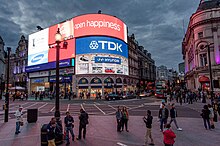
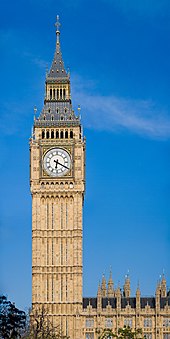
The City of Westminster contains some of the most famous sites in London, includingBuckingham Palace,Westminster Abbey,thePalace of Westminster(Houses of Parliament) andBig Ben.
Centre of London[edit]
Charing Crossis the notional centre ofLondonand the location where distinances from London are measured. This custom appears to have begun with the set distances of the 12Eleanor crossestoLincoln, Englandin the north, and expanded even after destruction of most the crosses.[26]
Parks and open spaces[edit]
These includeGreen Park,Hyde Park,Kensington Gardens,Regent's ParkandSt James's Park.In addition to parks and open spaces within the borough, the City owns and maintainsEast Finchley Cemeteryand crematorium in theLondon Borough of Barnet.
Transport[edit]
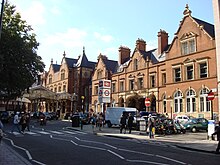
National Rail stations[edit]
Four National Rail stations serve the City of Westminster:
London Underground[edit]
The City of Westminster is served by 27London Undergroundstations and 10 of the 11 lines.
Electric charging points[edit]
By 2009 Westminster City Council had electric vehicle charging points in 15 locations through the city (13 car parks and two on-street points). Users pay an annual fee to cover administration costs to register and use the points.[33]By 2018 there were 60 electric vehicle charging locations.[34]
Travel to work[edit]
In March 2011, the main forms of transport that residents used to travel to work were: underground, metro, light rail, tram, 21.0% of all residents aged 16–74; on foot, 9.3%; bus, minibus or coach, 9.3%; driving a car or van, 6.0%; work mainly at or from home, 5.5%; bicycle, 3.1%; train, 3.0%.[35]
Education[edit]

Westminster Children's Services administers many primary and secondary schools. In addition, there are several state-funded faith schools, primarilyChurch of England(CE), andRoman Catholic(RC), but Christian non-denominational (ND) schools are also in the borough,[36]and there are several non-profit-making junior and seniorindependent schools.
Universities and colleges[edit]
- TheUniversity of Westminsterhas its three campuses in the borough; 309Regent Street(with 4–12 / 16 Little Titchfield Street and 32 / 38 Wells Street buildings uniting under the same campus), 115 New Cavendish Street, and 29 / 35Marylebone Road.
- TheStrandcampus ofKing's College Londonis located within the district.
- TheLondon Business School,inRegent's Park.
- TheLondon School of Economics,atClare Market,nearAldwych.
- TheRoyal Academy of Music,onMarylebone Road.
- University of the Arts Londonhas constituent colleges inMillbank(Chelsea College of Art and Design) andOxford Street(London College of Fashion).
- TheCourtauld Institute of Art,inSomerset House,Strand.
- Brigham Young UniversityLondon Centre, on Palace Court.
- The northern half ofImperial College London's mainSouth Kensingtoncampus lies within the borough.
- City of Westminster Collegeis afurther educationcollege with campuses onPaddington Greenand atQueens Park.It also owns theCockpit Theatre,which is used as a training and performance venue.
- Regent's College,whose campus is within the grounds of Regent's Park, which houses:European Business School London;Regent's American College London;Regent's Business School; School of Psychotherapy and Counselling;Webster Graduate School;Internexus, a provider of English language courses.
- Westminster Kingsway Collegeis a further education college with centres inSohoandVictoriain Westminster. It also has centres inCamden.
- TheRoyal College of Artin Kensington Gore.
Public libraries[edit]

TheLondon Library,an independent lending library, is at 14St James's Square.[37][38]
The city operates two reference libraries;Westminster Reference Libraryand Marylebone Information Service.[39]Westminster Reference Library holds several special collections: of which the Sherlock Holmes, Arts and Business collections are the most comprehensive.[40]In addition to the collections in Westminster Reference Library the city has two specialist libraries: the Westminster Music Library, the largest music library in the UK[41]and the Westminster Chinese Library in the Charing Cross Library.[42]
Free City of Westminster operated public lending libraries in Westminster include:
- Charing Cross Library[43]
- Church Street Library[44]
- The Maida Vale Library[45]
- Marylebone Library[46]
- Mayfair Library[47]
- Paddington Library[48]
- Pimlico Library[49]
- Queen's Park Library[50]
- St. John's Wood Library[51]
- Victoria Library[52]
Embassies and High Commissions[edit]
Many countries' embassies orHigh Commissionsare in Westminster.
Notable people[edit]
Coat of arms[edit]

The current Westminster coat of arms was given by an official grant on 2 September 1964.[53]
Westminster had other arms before, which had achiefidentical to the chief in the present arms. The symbols in the lower two thirds of the shield stand for former municipalities now merged with the city, Paddington and St Marylebone. The original arms had aportcullisas the main charge, which now forms thecrest.[53]
Freedom of the City[edit]
The following people and military units have received theFreedom of the Cityof Westminster.
Individuals[edit]
- Sir Winston Churchill:1946.[54]
- Sir Robert Mark:22 June 1977.[55]
- Margaret Thatcher:12 December 1990.[56]
Military units[edit]
- HMS Westminster,RN:11 December 2005.[57]
See also[edit]
Notes[edit]
- ^Cowie, Robert; Whitehead, Robert (1989)."Lundenwic: The archaeological evidence for middle Saxon London".Antiquity.63(241): 706–18.doi:10.1017/S0003598X00076845.
- ^Gray, p. 68
- ^Coke, Edward;Hale, Matthew;Nottingham, Heneage Finch, Earl of;Francis Hargrave, Charles Butler (1853). "109b, Note (3) [124]".A commentary upon Littleton.The Institutes of the laws of England. Vol. 1 (1st American, from 19th London ed.). Philadelphia: R. H. Small. Vol. 1 p.164.Archivedfrom the original on 20 May 2016.Retrieved17 May2010.
{{cite book}}:CS1 maint: multiple names: authors list (link); "December 1540; Grants, No.30".Letters and Papers, Foreign and Domestic, Henry VIII.Vol. 16: 1540–1541. London: Her Majesty's Stationery Office. 1898. pp. 174–175.Archivedfrom the original on 24 September 2018.Retrieved5 June2018– via British History Online. - ^Fasti Ecclesiae Anglicanae 1541–1857: Volume 7.London: Institute of Historical Research. 1992. pp. 65–67.Retrieved30 April2024.
- ^"Westminster".The History of Parliament.Retrieved30 April2024.
- ^Leigh, Samuel (1827).Leigh's New Picture of London.pp. 82–85.Retrieved30 April2024.
- ^Metropolis Management Act 1855(18 & 19 Vict. c. 120)
- ^"No. 26815".The London Gazette.19 January 1897. p. 337.
- ^London Government Act 1899(62 & 63 Vict. c. 14)
- ^"No. 27242".The London Gazette.30 October 1900. p. 6613.
- ^Webb, Beatrice (1963).The Manor and the Borough.Retrieved30 April2024.
- ^Youngs, Frederic (1979).Guide to the Local Administrative Units of England.Vol. I: Southern England. London:Royal Historical Society.ISBN0-901050-67-9.
- ^"Grant of title of city: London Borough of Westminster, 1964".The National Archives.Retrieved1 May2024.
- ^"No. 43921".The London Gazette.11 March 1966. p. 2704.
- ^"Migration and London's growth"(PDF).LSE.
- ^Ethnicity in the 1991 census: Vol 3 - Social geography and ethnicity in Britain, geographical spread, spatial concentration and internal migration.Internet Archive. London: HMSO. 1996.ISBN978-0-11-691655-6.
{{cite book}}:CS1 maint: others (link) - ^Ethnicity in the 1991 census: Vol 3 - Social geography and ethnicity in Britain, geographical spread, spatial concentration and internal migration.Internet Archive. London: HMSO. 1996.ISBN978-0-11-691655-6.
{{cite book}}:CS1 maint: others (link) - ^"Office of National Statistics; 2001 Census Key Statistics".webarchive.nationalarchives.gov.uk.Retrieved7 September2021.
- ^"2011 Census: Ethnic Group, local authorities in England and Wales".webarchive.nationalarchives.gov.uk.Retrieved15 December2021.
- ^"Ethnic group - Office for National Statistics".ons.gov.uk.Retrieved29 November2022.
- ^"KS007 - Religion".Retrieved30 January2016.
- ^"2011 census – theme tables".Archivedfrom the original on 4 March 2016.Retrieved8 January2016.
- ^"Religion - Office for National Statistics".
- ^Office for National Statistics 2011 Census Key Statistics: TenureArchived11 February 2003 at theWayback Machine.
- ^"London's Poverty Profile".Trust for London.Archivedfrom the original on 19 June 2018.Retrieved19 June2018.
- ^BBC (15 August 2005)."Where Is The Centre Of London?".bbc.co.uk.Retrieved5 July2023.
- ^"London's Rail and Tube Services"(PDF).Transport for London.Archived fromthe original(PDF)on 10 April 2019.
- ^ab"Explore our Network".Southeastern.Archived fromthe originalon 18 April 2019.
- ^"Route Map".Chiltern Railways.Archived fromthe originalon 27 April 2019.
- ^"Network Map"(PDF).Great Western Railway.Archived fromthe original(PDF)on 27 April 2019.
- ^"Elizabeth line Map".Transport for London.
- ^"Route Map"(PDF).Southern.Archived fromthe original(PDF)on 27 April 2019.
- ^"City of Westminster: Additional on street charging points for electric vehicles".Archived fromthe originalon 5 May 2009.Retrieved4 April2012.
- ^"Electric Vehicles".Archivedfrom the original on 23 December 2018.Retrieved22 December2018.
- ^"2011 Census: QS701EW Method of travel to work, local authorities in England and Wales".Office for National Statistics.Archivedfrom the original on 15 September 2013.Retrieved23 November2013.Percentages are of all residents aged 16–74 including those not in employment. Respondents could only pick one mode, specified as the journey's longest part by distance.
- ^Westminster Education serviceaccessed 17 May 2007
- ^"LibrariesArchived8 May 2009 at theWayback Machine."City of Westminster. Retrieved on 21 January 2009.
- ^"VisitArchived3 March 2016 at theWayback Machine."The London Library. Retrieved on 21 January 2009.
- ^"Westminster Find a LibraryArchived24 September 2018 at theWayback Machine."City of Westminster. Retrieved on 25 September 2015.
- ^"Westminster Reference LibraryArchived13 March 2016 at theWayback Machine."City of Westminster. Retrieved on 25 September 2015.
- ^";Westminster Music LibraryArchived14 April 2009 at theWayback Machine."City of Westminster. Retrieved on 21 January 2009.
- ^"Westminster Chinese LibraryArchived7 February 2009 at theWayback Machine."City of Westminster. Retrieved on 21 January 2009.
- ^"Charing Cross LibraryArchived31 January 2009 at theWayback Machine."City of Westminster. Retrieved on 21 January 2009.
- ^"Church Street LibraryArchived5 February 2009 at theWayback Machine."City of Westminster. Retrieved on 21 January 2009.
- ^"Maida Vale LibraryArchived5 February 2009 at theWayback Machine."City of Westminster. Retrieved on 21 January 2009.
- ^"Marylebone LibraryArchived7 February 2009 at theWayback Machine."City of Westminster. Retrieved on 21 January 2009.
- ^"Mayfair LibraryArchived5 February 2009 at theWayback Machine."City of Westminster. Retrieved on 21 January 2009.
- ^"Paddington LibraryArchived29 January 2009 at theWayback Machine."City of Westminster. Retrieved on 21 January 2009.
- ^"Pimlico LibraryArchived5 February 2009 at theWayback Machine."City of Westminster. Retrieved on 21 January 2009.
- ^"Queen's Park LibraryArchived31 January 2009 at theWayback Machine."City of Westminster. Retrieved on 21 January 2009.
- ^"St. John's Wood LibraryArchived15 February 2009 at theWayback Machine."City of Westminster. Retrieved on 21 January 2009.
- ^"Victoria LibraryArchived17 February 2009 at theWayback Machine."City of Westminster. Retrieved on 21 January 2009.
- ^ab"Westminster (London)".Heraldry of the world.Archivedfrom the original on 2 February 2018.Retrieved25 October2015.
- ^"Churchill Receives Freedom of Westminster".Archivedfrom the original on 2 November 2021 – via YouTube.
- ^"Recognition & Awards".Archivedfrom the original on 7 October 2019.Retrieved7 October2019.
- ^"Speech receiving Freedom of City of Westminster".Margaret Thatcher Foundation. 12 December 1990.Archivedfrom the original on 30 November 2018.Retrieved30 November2018.
- ^"Ship is granted freedom of city".11 December 2005.Archivedfrom the original on 7 October 2019.Retrieved7 October2019– via news.bbc.co.uk.
References[edit]
- Gray, Robert,A History of London,Hutchinson & Co, London, 1978,ISBN0-09-133140-4
External links[edit]
- City of Westminster
- Westminster,by Sir Walter Besant and Geraldine Edith Mitton and A. Murray Smith, 1902, fromProject Gutenberg
- Westminster City CouncilYouTubechannel
- West End Extra:A local newspaper covering the City of Westminster






